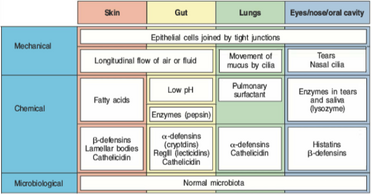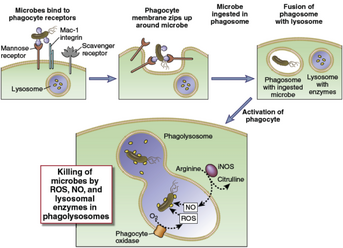5. Innate immunity, pattern recognition

We often think of “immunity” to only be about T-cells, B-cells and cytokines. But the first line of defence against pathogens is something much simpler, which also stops most of threats. This first line of defence are the anatomical barriers of your body.
Every body surface that faces the “outside”, like skin, gastrointestinal tract, lungs, eyes, nasal and oral cavities are all composed of epithelial cells that are joined by tight junctions, which pathogens (mostly) cannot penetrate. The GI tract has low pH (in the stomach) and enzymes that break down pathogens or incapacitate them, the skin has oils and the lungs have pulmonary surfactant, mucus and cilia that move dirt and such out. Another very important component of this line of defence are antimicrobial peptides.
Antimicrobial peptides
These peptides are secreted by cells on the surfaces of the body. They often work by entering the cell membrane and creating a “pore” in it, which ruins the whole purpose of having a cell membrane anyway; everything inside will flow out, and the cell will die. Two large families of antimicrobial peptide called defensins and cathelicidins do just that.
Both gram-negative and gram-positive bacteria have peptidoglycans, peptides with carbohydrates, covering and protecting their cell membranes from the effects of defensins and cathelicidins. The body can secrete lysozymes to break down these peptidoglycans, which exposes the lipid bilayer that the antimicrobial peptides can enter and rupture.
Immune cells embedded in the epithelium also work towards killing pathogens. Mast cells or intraepithelial lymphocytes like γδ T cells do just this.
Second line of defence
The second line of defence is composed of the innate immunity, phagocytes and inflammation. Phagocytes in the blood and tissues phagocyte pathogens, while soluble proteins in the blood enhance this activity. Immunoglobulins and proteins of the complement system bind to the surface of the pathogen to make it easier for phagocytes to eat them. This is called opsonization.
(The third line of defence is the adaptive immune system, a different topic.)
Pattern recognition receptors
To kill pathogens, the cells must first be able to recognize them. Pattern recognition receptors (PRRs) are mainly found on the cell surface of cells of the innate immune system, like dendritic cells, macrophages, monocytes, neutrophils, but also epithelial cells. They bind to molecules that your body knows are only found on pathogens. For simplicity, these molecules are called pathogen associated molecular patterns, or PAMPS.
There are many different types of PAMPS, so there are many different types of pattern recognition receptors to recognize these molecules. They can be summed up most easily in a table.
| Receptor type | Location | Receptors and what they recognize (if important) |
|---|---|---|
| Toll-like receptors (TLRs) | Cell membrane and endosomal membrane of dendritic cells, phagocytes, B cells, endothelial cells, and others | TLR3 – dsRNA
TLR4 – LPS TLR5 – flagellin TLR7 – ssRNA |
| NOD-like receptors (NLRs) | Cytoplasm of phagocytes, epithelial cells, and others | NOD1, NOD2, NALP family |
| RIG-like receptors (RLRs) | Cytoplasm of phagocytes and others | RIG-1 – viral RNA
MDA-5 – viral RNA |
| C-type lectin-like receptors | Cell membrane of phagocytes | Mannose receptor – mannose
Dectin – fungal cell walls |
As seen in the table above, many types of receptors exist, which recognize many things. Every molecule they recognize is a molecule that is only found in either viruses, bacteria, fungi, parasites or other pathogens. Double stranded and single stranded RNA are both found in viruses. Lipopolysaccharide (LPS) is found in the cell membrane of gram-negative bacteria. Flagellin is the protein that bacteria use to propel themselves around. Mannose is a sugar only found on cell membranes of bacteria.

The RIG-like receptors are located inside the cell and are activated when the cell becomes infected with a virus. The receptors activate transcription of proteins like interferons α and β, to warn other cells to kill it.
However, not all pattern recognition receptors are found on or in cells. There exist also soluble pattern recognition receptors, like antibodies.
In response to bacterial infection, macrophages produce interleukin-6, which signals the liver to start producing some proteins called acute-phase proteins which we will read more about later. Some of these are soluble PRRs. Other soluble pattern recognition receptors are C1q, which binds to an IgM that are already bound to an antigen and ficolin which binds N-acetylglucosamine.
